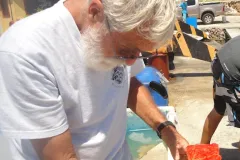Searching for Cancer Drugs in the Ocean

Ever since fourth grade I’ve wanted to explore the creatures and landscapes of the deep ocean in a submersible. It took awhile, but I finally got my chance this summer as part of the Deep Reef Observation Project (DROP). What I experienced during my three-hour dive and subsequent visits to the lab included many aspects of science that I love so much: the sense of awe and wonder that investigating the unknown elicits; the teamwork; the creative problem solving; and all the learning that generates more questions than answers!
As a science educator, I accompanied two marine scientists, Dr. Patrick Colin of the Coral Reef Research Foundation in the Republic of Palau and Dr. Belinda Alvarez de Glasby, from the Northern Territory Museum in Darwin, Australia, in their search of sponges and other marine organisms with potential biopharmaceutical use.
Colin and Alverez de Glasby work for the National Cancer Institute with a program which has been running for over 20 years and produced many exciting leads for new cancer treatment drugs. Because sponges and other sessile invertebrates do not move (at least on our time scale, but that is another story!), they have many bioactive compounds, some of which have been shown to have antibacterial, antifungal, or antitumor properties.
Few people get to descend to the deep ocean, so we were also on the lookout for specimens of interest to other colleagues, and species from the region not yet archived in a museum collection.
The life we saw was diverse, and it was incredible to think about all of the things the sub's light did not illuminate. While we searched the area for critters, my gaze routinely moved to the water column where I was dumbfounded by the amount of life I saw: complex but delicate colonial siphonophores, winged snails known as pteropods, and tons of animals I had no clue about. So much to explore!
I was also surprised by the incredible skill of our sub pilot, Bruce Brandt. He was an invaluable part of the research. Not only is he one of few people who can maneuver a sub, he also knows the deep reef near the field station like the back of his hand. He listened to the scientists’ interests and then navigated the sub to areas that had promise. No GPS, no map, just pure experience and knowledge.
Lots of creativity is needed in this line of work The sub wields a steel pipe, or battering ram, added in response to the challenges of collecting animals like sponges that are “cemented” to the rock. With it, we were able to pry off a stony “sclerosponge” that neither Pat nor Belinda knew existed. On-the-fly creative solutions contributed to our success in getting hard-to-reach slit-shell snails, a delicate sea anemone, and more. Some of our attempts didn’t work, such as sending a scuba diver to meet the sub to isolate an armored sea robin, but luckily we were still able to get the fish safely to the lab.
What will be gained from these finds? What useful bio-active compounds will be discovered in the tissues of these animals? Is the sea robin a new species? How much more is down there that has never been documented? The specimens we collected will be used by DROP scientists and researchers from around the world for decades to address these questions and many more. I just love science!
Editor's Note: This is the fifth post in our "Summer in a Sub" blog series, which features the work of the Smithsonian's Deep Reef Observation Project (DROP).

